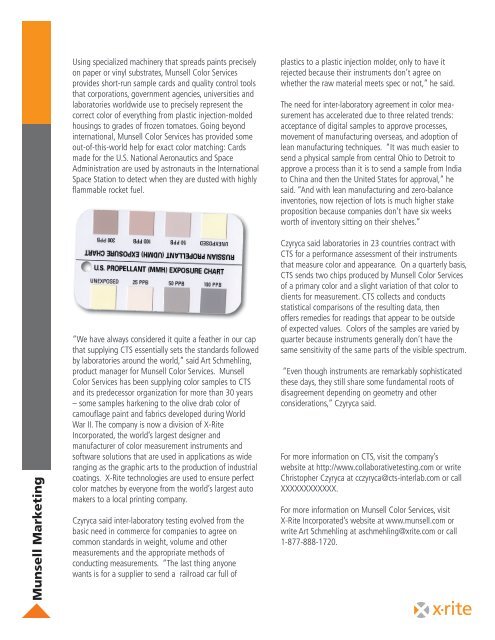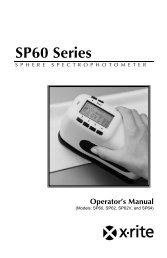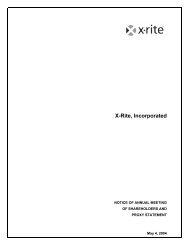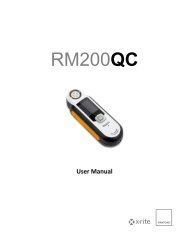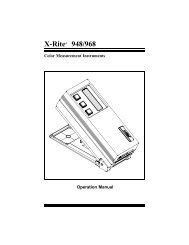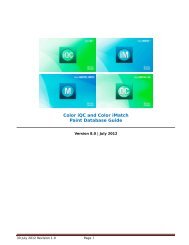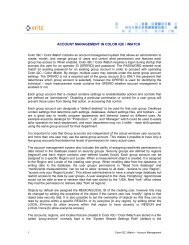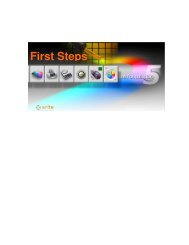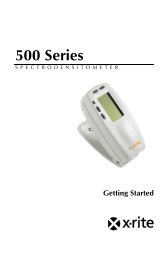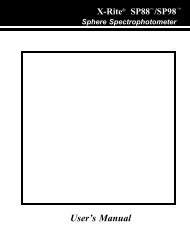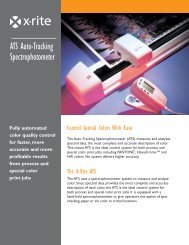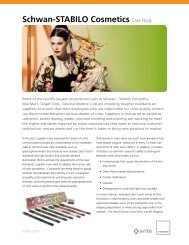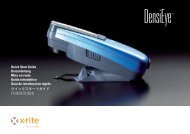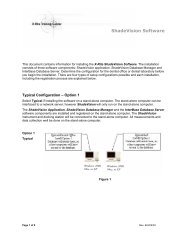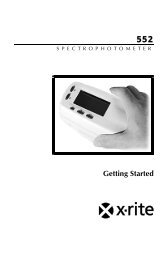Munsell & Collaborative Testing Services - X-Rite
Munsell & Collaborative Testing Services - X-Rite
Munsell & Collaborative Testing Services - X-Rite
Create successful ePaper yourself
Turn your PDF publications into a flip-book with our unique Google optimized e-Paper software.
<strong>Munsell</strong> Marketing<br />
Using specialized machinery that spreads paints precisely<br />
on paper or vinyl substrates, <strong>Munsell</strong> Color <strong>Services</strong><br />
provides short-run sample cards and quality control tools<br />
that corporations, government agencies, universities and<br />
laboratories worldwide use to precisely represent the<br />
correct color of everything from plastic injection-molded<br />
housings to grades of frozen tomatoes. Going beyond<br />
international, <strong>Munsell</strong> Color <strong>Services</strong> has provided some<br />
out-of-this-world help for exact color matching: Cards<br />
made for the U.S. National Aeronautics and Space<br />
Administration are used by astronauts in the International<br />
Space Station to detect when they are dusted with highly<br />
flammable rocket fuel.<br />
“We have always considered it quite a feather in our cap<br />
that supplying CTS essentially sets the standards followed<br />
by laboratories around the world,” said Art Schmehling,<br />
product manager for <strong>Munsell</strong> Color <strong>Services</strong>. <strong>Munsell</strong><br />
Color <strong>Services</strong> has been supplying color samples to CTS<br />
and its predecessor organization for more than 30 years<br />
– some samples harkening to the olive drab color of<br />
camouflage paint and fabrics developed during World<br />
War II. The company is now a division of X-<strong>Rite</strong><br />
Incorporated, the world’s largest designer and<br />
manufacturer of color measurement instruments and<br />
software solutions that are used in applications as wide<br />
ranging as the graphic arts to the production of industrial<br />
coatings. X-<strong>Rite</strong> technologies are used to ensure perfect<br />
color matches by everyone from the world’s largest auto<br />
makers to a local printing company.<br />
Czyryca said inter-laboratory testing evolved from the<br />
basic need in commerce for companies to agree on<br />
common standards in weight, volume and other<br />
measurements and the appropriate methods of<br />
conducting measurements. “The last thing anyone<br />
wants is for a supplier to send a railroad car full of<br />
plastics to a plastic injection molder, only to have it<br />
rejected because their instruments don’t agree on<br />
whether the raw material meets spec or not,” he said.<br />
The need for inter-laboratory agreement in color measurement<br />
has accelerated due to three related trends:<br />
acceptance of digital samples to approve processes,<br />
movement of manufacturing overseas, and adoption of<br />
lean manufacturing techniques. “It was much easier to<br />
send a physical sample from central Ohio to Detroit to<br />
approve a process than it is to send a sample from India<br />
to China and then the United States for approval,” he<br />
said. “And with lean manufacturing and zero-balance<br />
inventories, now rejection of lots is much higher stake<br />
proposition because companies don’t have six weeks<br />
worth of inventory sitting on their shelves.”<br />
Czyryca said laboratories in 23 countries contract with<br />
CTS for a performance assessment of their instruments<br />
that measure color and appearance. On a quarterly basis,<br />
CTS sends two chips produced by <strong>Munsell</strong> Color <strong>Services</strong><br />
of a primary color and a slight variation of that color to<br />
clients for measurement. CTS collects and conducts<br />
statistical comparisons of the resulting data, then<br />
offers remedies for readings that appear to be outside<br />
of expected values. Colors of the samples are varied by<br />
quarter because instruments generally don’t have the<br />
same sensitivity of the same parts of the visible spectrum.<br />
“Even though instruments are remarkably sophisticated<br />
these days, they still share some fundamental roots of<br />
disagreement depending on geometry and other<br />
considerations,” Czyryca said.<br />
For more information on CTS, visit the company’s<br />
website at http://www.collaborativetesting.com or write<br />
Christopher Czyryca at cczyryca@cts-interlab.com or call<br />
XXXXXXXXXXXX.<br />
For more information on <strong>Munsell</strong> Color <strong>Services</strong>, visit<br />
X-<strong>Rite</strong> Incorporated’s website at www.munsell.com or<br />
write Art Schmehling at aschmehling@xrite.com or call<br />
1-877-888-1720.


